Research - (2022) Volume 3, Issue 4
The automobile sector started shifting its dependency from fossil fuel to electrical energy in the last few decades to mitigate adverse environmental scenarios like global warming, air pollution, etc. Due to this, the battery is emerging as the new source of power. At the same time, the use of bikes for city transportation has been growing at a high rate in developed countries. For a heavily congested mega city like Dhaka, electric bikes can provide a better alternative to traditional fossil fuel vehicles. They are not only costeffective but also faster and can contribute to improved public health outcomes. With such a background study, an initiative was taken to fabricate an electric bike. This paper presents a study of its chassis design and analysis. The triangular structure was used as the basis of the design since this concept provides the best structural strength. Mechanical properties such as stress, strain, and deformation at critical locations within the fabricated chassis were compared with numerical results obtained from the state-of-the-art FEA software ANSYS. The validated numerical method allowed to simulate the dynamic performance of the chassis by predicting the forces on the structural member during acceleration and braking. It is expected that the developed numerical methodology will allow conducting exploratory designs with confidence.
Global warming • Electric bike • Chassis • Triangulation • ANSYS
The need for alternative fuel vehicles emerged in the 1960s and 1970s due to the increased pollution from internal combustion engines, rising prices, reliance on crude oil, and its diminishing supply. Since then, significant efforts have been made to develop workable electric vehicles to replace present IC engine vehicles. Despite rapidly expanding technology, electric two-wheelers have some flaws that must be tackled to improve the vehicle's overall performance. The weight and size of the systems and components are the primary concerns that need to be addressed to increase the vehicle's range, speed, payload, and grade ability. Advancements in materials, improved design and analysis methods, fabrication processes, and optimization techniques paved the way for weight reduction. Topology optimization can be an effective procedure to obtain a minimum weight with maximum performance, based on the removal of conflicting constraints, design boundaries, and design uncertainties, such as design clearance and material defects.
A motorcycle chassis is a motorcycle's core structure. The chassis acts as a skeleton for the vehicle on which different components are mounted using bolted applications providing them with strength and rigidity so that they can carry out their desired operations. Power generating components (IC engine for a conventional fossil fuel vehicle while motor and batteries for an electric vehicle) are mounted on the chassis in such a way that they are protected in cases of accidents and impacts while ensuring there is no hindrance in their smooth functioning. The chassis provides the hinge points for both front and rear suspension and supports the rider and any pillion or luggage. It is required to sustain numerous forces and torques induced by bumping, braking, and acceleration.
A chassis design is dependent on the suspension, steering, and transmission subassembly of the particular vehicle and hence gives the flexibility to optimize it in terms of weight and durability. Among all the structural components of the vehicle, the chassis is the most important part. The centralization and reduction in weight of the chassis improve the vehicle's handling and performance. Under normal operating conditions, it is subjected to dynamic forces transmitted from the front and rear suspension systems. It also encounters time-varying loads during its service life which may lead to fatigue failure. Thus, in the design and optimization of a motorcycle chassis, the weight must be minimized, centralized, and lowered, while factors such as strength, stiffness, and durability should fulfill the design targets.
An effective design performs the required task efficiently and is safe under extreme operating conditions while being economical in the material used as well as the manufacturing process needed yet having an aesthetic appeal. Analysis facilitates understanding the behavior of a component under a particular loading cycle for both failures and redundancies. Therefore, the analysis provides us with a mathematical model which indicates the scope for optimization and weight reduction for an overdesigned component.
Foale (2002) provided practical and applicable design guidelines and theories to design and fabricate a motorcycle chassis. He elaborated on various geometries associated with chassis building and the different forces and moments on the chassis and other vehicle systems during the dynamic behavioral conditions like acceleration, braking, cornering, etc. of the vehicle. The author explained the use and applications of various materials and cross-section types of the chassis along with various manufacturing processes for the fabrication of the motorcycle chassis.
Cossalter (2006) portrayed the evolutionary change of motorcycle chassis in the last two decades. The execution of his empirically-developed alternative motorcycle formats was exemplary. He demonstrated the relevance of different fork angles and trails in offering different dimensions of steering geometry. He established the fact that the “classic” figures for rake and trail can diverge without trouble a contention supported by a couple of projects carried out by the author himself on a BMW R75, in which rake figures down to zero (vertical forks) and trail dimensions between 50 mm and 100 mm were tried.
The concepts behind the mathematical modeling of the component understudy with emphasis on the mesh generation and mesh relevance parameters. Their work is a skeletal structure on which the FEA method for the steering knuckle optimization is developed [1].
The chassis of a two-wheeler, two-seater motorcycle for an electric mobility purpose, while considering the strength, safety, and optimum performance of the vehicle. The said study has been carried out with a twostep approach. The first step 25 included modeling of the chassis as per structural and ergonomic considerations, the design constraints governed by the front and rear suspension, steering and transmission systems and assemblies as well as the determination of loads acting on the chassis. The second step was stress analysis using finite element analysis software and design modifications for weight reduction without affecting structural strength. It was clear from the analysis that the displacement during worst load cases was well within limits. The essential components like the battery pack and the motor were safe from the critical forces acting on the chassis [2].
A system based on longitudinal vehicle dynamics and the electrical motor. Differently from a common approach in which the electric motor is located on one of the three hubs of the e-bike, the idea of the pedicel prototype presented in the paper consisted of an electrical motor in the central position that transmitted the torque on the central hub.
Develop a driving cycle of the auto-rickshaw in a typical large Indian city, in their case, Delhi. First, they considered the existing driving cycles used in India. Since these data were not applicable, GPS data collected at various times of the day were applied to the analysis. They derived the new driving cycle from the gathered information via GPS data as well as surveys of auto-rickshaw drivers in India, which helped to get the entire picture of the driving cycle [3].
The chassis of mountain bikes and then designed the chassis with low cost that satisfied all the conditions of users. They performed a structural and dynamic analysis of the designed chassis in regards to composite materials composed of the epoxy resin matrix and kevlar and polyisocyanate fiber [4].
The chosen methodology for this thesis project is shown below (Figure 1).
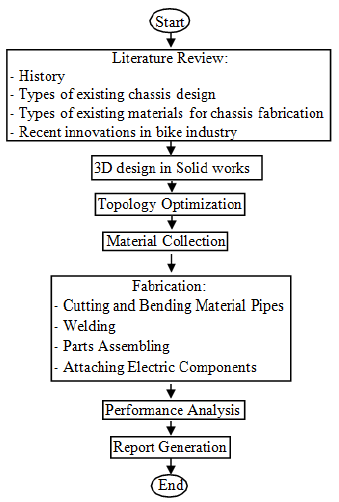
Figure 1: Method for this thesis project
Calculation of Forces on Motorcycle
Hypothesis
Several assumptions will be considered while analyzing the forces applied to the motorcycle (Figure 2).
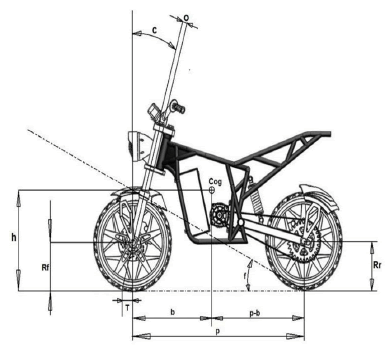
Figure 2: Bike schematics with different geometric parameters.
• The rear assembly (chassis, saddle, and motor-transmission drive train)
• The front assembly (fork, steering head, and handlebars)
• The front wheel
• The rear wheel
Bike parameters
Forces acting on the bike during maximum acceleration
Table 1. For performing the analysis of the chassis, Mild Steel (AISI 1020) is used. The weight of the bike is considered to be acting downward from CoG and its value is = m × g = 85 × 9.81 = 833.85 N.
| Symbol | Parameter | Numerical Value |
|---|---|---|
| p | Wheelbase | 833 mm |
| b | CoG to front | 373 mm |
| p-b | CoG to rear | 460 mm |
| Rf | Front-wheel radius | 188 mm |
| Rr | Rear-wheel radius | 188 mm |
| h | CoG height | 331 mm |
| c | Caster angle | 17o |
| t | Trail | 67 mm |
| f | Load transfer angle | 25o |
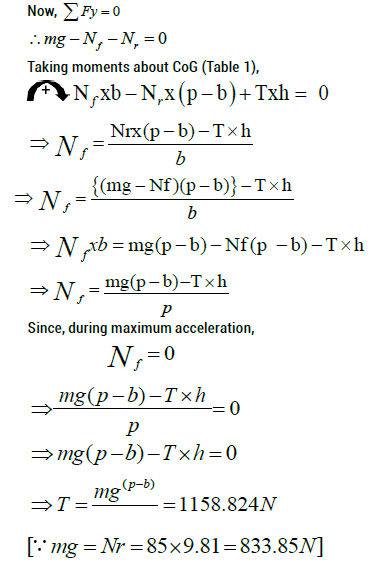
Chain force is considered during maximum acceleration so that force transmission can be calculated accurately. Contact forces from the floor against the rear tire are transmitted to the chassis through the wheel, swing arm, and bearings (Shown in figure 3, 4 and 5). The points of application of these forces to the chassis are both steering bearings (Figure 6, 7 and 8). The steering axle is kept fixed and the forces are transmitted to the chassis via the swing arm axle [4].
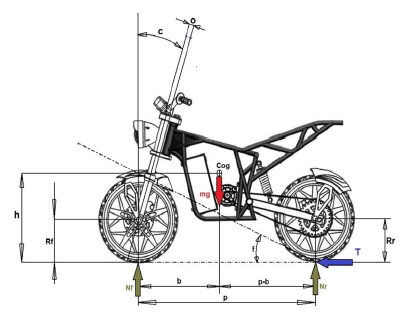
Figure 3: External forces act on the bike during maximum acceleration.
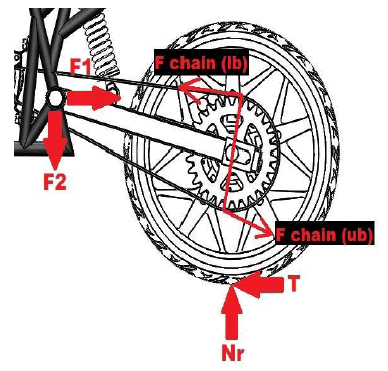
Figure 4: Forces acting on swing arm axle and chain forces during maximum acceleration.
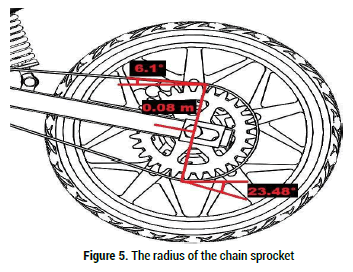
Figure 5: The radius of the chain sprocket
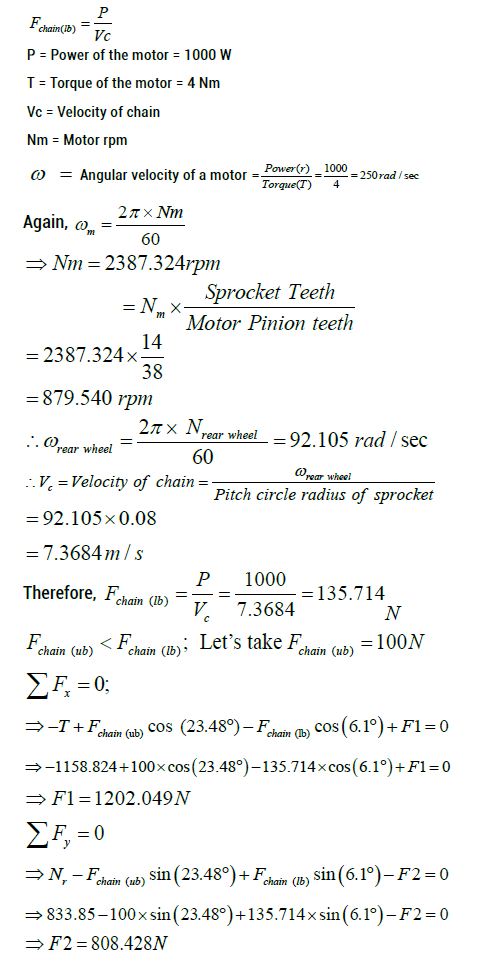
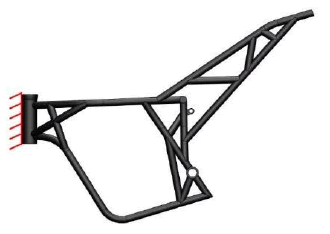
Figure 6: Applied constraints
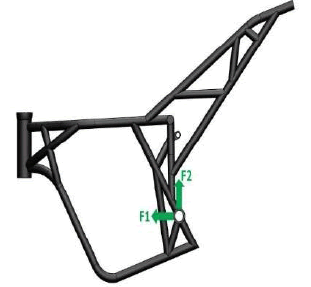
Figure 7: Applied Force.
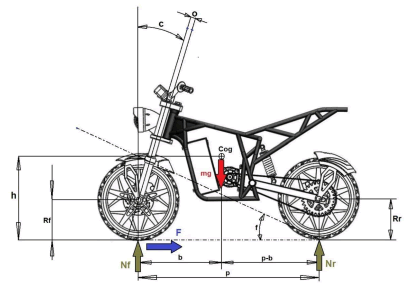
Figure 8: External forces acting on the bike during maximum braking to the front axle.
Forces acting on the bike during maximum braking to the front axle
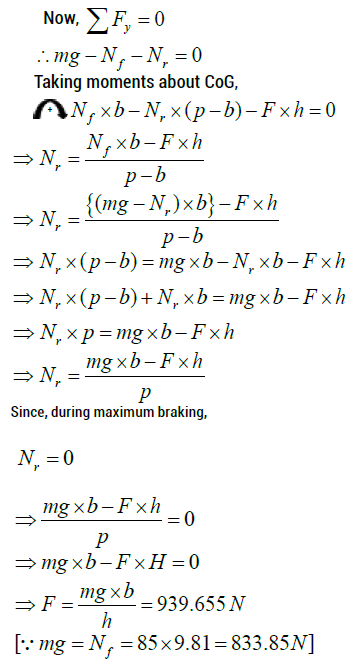
Contact forces from the floor against the tire are transmitted to the chassis through the wheel, brake, front suspension, and steering (Figure 9 and 10). The points of applications of these forces to the chassis are both steering bearings. The following schematics show various parameters at the front part of the motorcycle (Figures 11 and 12) [5].
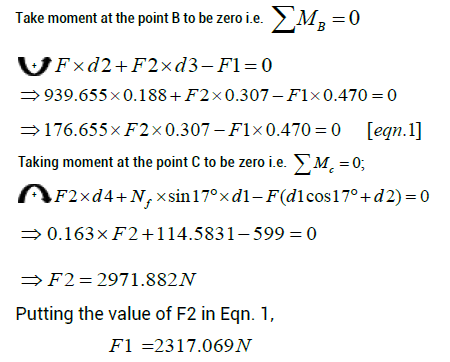
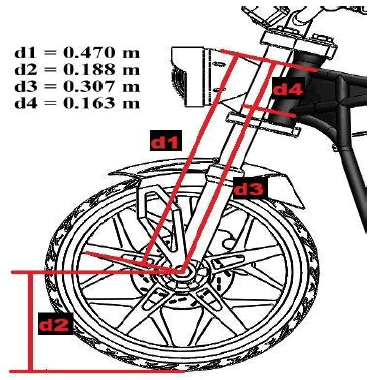
Figure 9: Parameters at the front part of the bike (m).
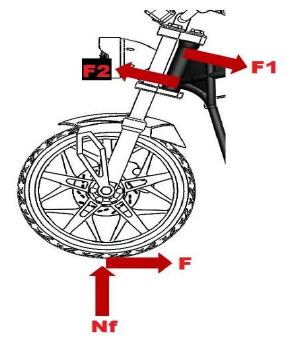
Figure 10: Forces acting during maximum braking to the front axle.

Figure 11: Applied constraints.
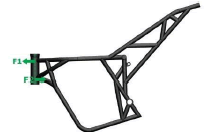
Figure 12: Applied force.
Once external forces in different situations are obtained, they can be applied to the chassis and results can be analyzed with the help of a finite element program. FEM (Finite Element Method) is a numerical technique for analyzing engineering designs. FEM divides the designed model into many small pieces of simple shapes called an element. The purpose of this element is to break a complex problem into many simple problems that need to be solved simultaneously [6-8].
The process of dividing the model into small pieces is called meshing. Analysis using FEM is called a Finite Element Analysis (FEA).
Elements share common points called nodes. The response at any point in an element is interpolated from the response at the element nodes. Each node is fully described by several parameters. In our thesis project, we used ANSYS as the finite element program.
ANSYS simulation formulates the equations governing the behavior of each element taking into consideration its connectivity to another element. These equations relate the response to known material properties, restraints, and loads [9].
In stress analysis, the solver finds the displacements at each node and then the program calculates strains and finally stresses. Static studies calculate displacements, reaction forces, strains, stresses, and factors of safety distribution. Material fails when stresses exceed a certain level.
Finite element programs have different steps as a process to obtain the final result:
• Firstly, it is needed to upload the geometry that will be analyzed in ANSYS.
• Secondly, it is necessary to perform the meshing. Meshing is done in two sub-steps. The first one involves making a general mesh and then getting its results; the second meshing is performed by emphasizing the more important parts. Thus, we can obtain more accurate results at the critical locations of the designed chassis [10].
• After meshing, the boundary conditions are to be described (which are the places where displacement doesn’t exist or in other words, constraints). Then external conditions such as forces or moments are to be defined [11].
• Finally, the system is to be solved and then an analysis of each result obtained is done. In our thesis project, we have calculated displacements, strains, stresses, and factors of safety of the chassis. Materials will fail at the locations where stress exceeds the pre-defined Von Mises Stress. Based on the results, topology optimization of the chassis is carried out. Thus, we could end up with the design having the most efficient mechanical features and economic viability [12-13].
Maximum acceleration
The simulation results are shown below (Figure 13):
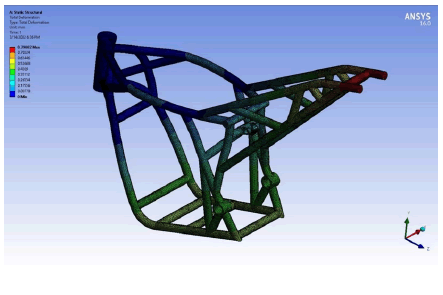
Figure 13: Deformation of the chassis (mm).
The maximum deformation of the chassis is 0.79002 mm (Figure 14). The minimum factor of safety is 3.2061. The factor of safety is well above unity at all locations of the chassis and so the design can be considered safe and perfect during maximum acceleration.
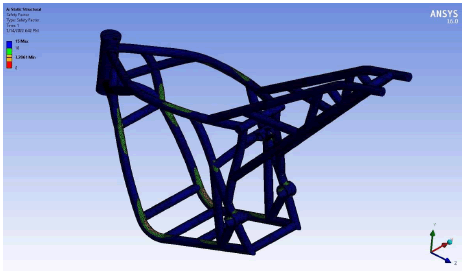
Figure 14: The factor of safety of the chassis
Maximum braking to the front axle
The simulation results are shown below (Figure 15):
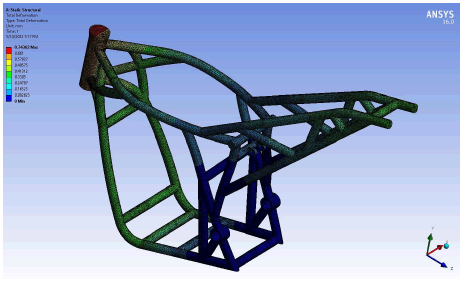
Figure 15: Deformation of the chassis (mm)
The minimum factor of safety is 2.9317 (Figure16). A factor of safety is well above unity at all locations of the chassis and so the design can be considered safe and perfect during maximum braking to the front axle [14-16].
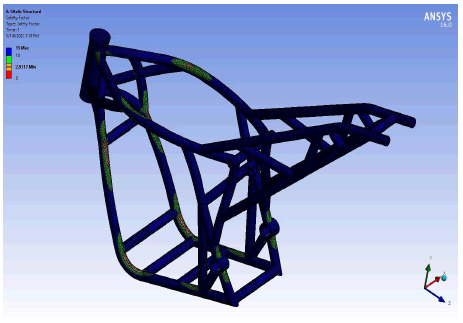
Figure 16: A factor of safety of the chassis
• The analysis performed is a static structural analysis of the chassis. For further improvement of the system and observing the behavior of the chassis during dynamic loading, fatigue analysis can be considered.
• The study does not include optimization of the chassis to reduce the weight without compromising much on the strength and rigidity of the chassis. Thus, further optimization and analysis can be performed.
• Similar to the chassis, many other motorcycle components can be designed and subjected to FEA study to be used in the design and development of electric motorcycles.
The number of automobiles on the roads throughout the globe is increasing at a staggering rate year by year, but the dependence on oilbased fuel grows almost unchecked. Due to this, electric vehicles come into the picture as an alternative. The need for an affordable and efficient mode of transport created a growing demand for electric motorcycles. This paper is taken as an opportunity, rather than a challenge to design and develop the best in class electric motorcycle for the quotidian commute. One of the motivations of this paper was to make the chassis of the motorcycle more secure and more reliable so that it can negotiate all the driving conditions in the best possible manner. Much emphasis was put on making the motorcycle chassis as strong as possible to withstand crash and fatigue.
Dynamic features are important to predict future behavior and so modal analysis was performed on the chassis. It’s vitally important to know the external forces as best as possible to calculate the internal forces acting on the chassis during maximum acceleration and maximum braking. Deformation and factors of safety of the chassis were determined by considering all these forces.
It’s highly desired that the motorcycle’s overall design and construction will increase its road performance and meet customer needs if made commercially available. All-in-all, this electric motorcycle can be an aspiring solution to a rather bigger problem than just being a day-today commuter. It can be a step towards an eco-friendly and sustainable mode of transportation.
Fahim Foysal Arnob, is a final year undergraduate in the Department of Mechanical Engineering, Military Institute of Science and Technology, Dhaka, Bangladesh. He started his undergraduate study in 2017. Mr. Fahim is currently serving as a Lieutenant in Bangladesh Army and also conducting his final year thesis on “Design, Fabrication, and Analysis of Chassis for Electric Bike”. His research interests include designing, simulation, and material handling.
Md. Shahnewaz Khan, is a final year undergraduate in the Department of Mechanical Engineering, Military Institute of Science and Technology, Dhaka, Bangladesh. He started his undergraduate study in 2018. Mr. Shahnewaz is currently conducting his final year thesis on “Design, Fabrication, and Analysis of Chassis for Electric Bike”. His research interests include designing, simulation, and material handling.
Brigadier General Md. Humayun Kabir Bhuiyan, PSC is a Senior Instructor and Dean of the Faculty of Mechanical Engineering, Military Institute of Science and Technology, Dhaka, Bangladesh. He earned B Sc and M Sc in Mechanical Engineering from Bangladesh University of Engineering and Technology, Bangladesh, and undergoes a Ph.D. in Mechanical Engineering from the Military Institute of Science and Technology. Brig Gen Humayun has served in various EME units of the Bangladesh Army in various appointments. He has already published many refereed journal papers, conference papers, and book chapters. His research activities include the area of Operations Research & Management, Military Hovercraft, Subsonic Wind Tunnel, Sustainable Product Design, Maintenance Engineering, Small Arms and Military Optical equipment, and Renewable Energy. He has an affiliation with IEB (Bangladesh).
Citation: Arnob F, Design, Fabrication and Analysis of Chassis for Electric Bike. Int J Innov Res Sci Eng Technol. 2022, 3(4),25- 31.
Received: 08-Apr-2022, Manuscript No. IJIRSET-22-59980; Editor assigned: 14-Apr-2022, Pre QC No. IJIRSET-22-59980(PQ); Reviewed: 20-Apr-2022, QC No. IJIRSET-22-59980(Q); Revised: 26-Apr-2022, Manuscript No. IJIRSET-22-59980(R); Published: 10-May-2022, DOI: 10.35248/ ijirset.22.3(4).25-31
Copyright: ©2022 Arnob F. This is an open-access article distributed under the terms of the Creative Commons Attribution License, which permits unrestricted use, distribution, and reproduction in any medium, provided the original author and source are credited.